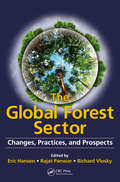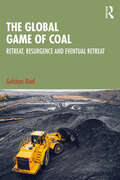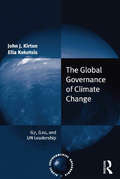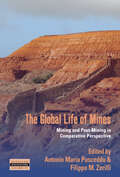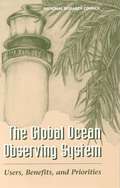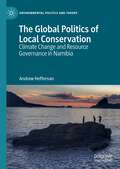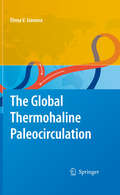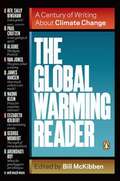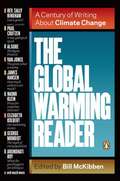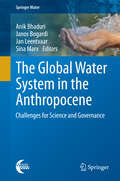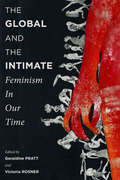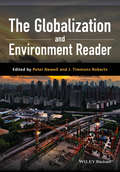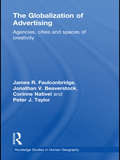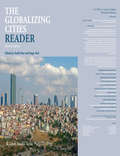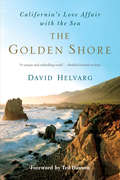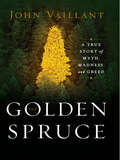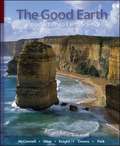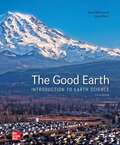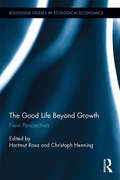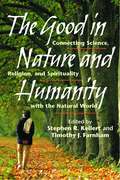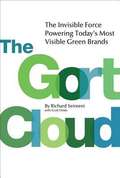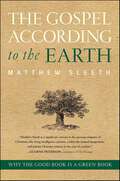- Table View
- List View
The Global Forest Sector: Changes, Practices, and Prospects
by Eric Hansen Rajat Panwar Richard VloskyChanges in production, demand, supply, and trade patterns; the impact of green building and bioenergy on industry practices and policy infrastructure; and new economies with production advantages and large consumption bases all present challenges and opportunities in the forest sector. With contributions from leading experts in academia and profess
The Global Game of Coal: Retreat, Resurgence and Eventual Retreat
by Gulshan DietlCoal occupies a large share in the global energy basket. This book explores the ‘coal game’ within the context of shifting energy geopolitics, the ‘resource war’, and the debates over climate change and energy security.Politics is a prime arena for game playing. Collaboration, competition, confrontation, and their combinations are ingredients in bilateral and multilateral dealings. The book deciphers the interactions within the coal world by resorting to the time-tested term ‘global game’. Joe Manchin in the United States, Vladimir Putin in Russia, Scott Morrison in Australia, and Gautam Adani in Australia and India have been accomplished players in the game of coal. The book looks at the coal assets and policies of major oal exporters and importers like the United States, Russia, India, Australia, and China and provides insights into the fierce contestations involved both in local and global politics and commerce over coal, climate, and security. The author discusses the role coal has played in the industrialisation of nations, prescriptions to the problem of coaluse, and varied scenarios portraying its future.The third volume in a trilogy on the use of fossil fuels, this book on coal will be of great interest to students and researchers of energy studies, international relations, environment and climate change, energy and geopolitics, security, and strategic studies. It will also be useful to policymakers, legislators, and environmentalists.
The Global Governance of Climate Change: G7, G20, and UN Leadership (Global Environmental Governance)
by John J. Kirton Ella KokotsisClimate change control has risen to the top of the international agenda. Failed efforts, centred in the United Nations, to allocate responsibility have resulted in a challenge now reaching crisis stage. John J. Kirton and Ella Kokotsis analyse the generation and effectiveness of four decades of intergovernmental regimes for controlling global climate change. Informed by international relations theories and critical of the prevailing UN approach, Kirton and Kokotsis trace the global governance of climate change from its 1970s origins to the present and demonstrate the effectiveness of the plurilateral summit alternative grounded in the G7/8 and the G20. Topics covered include: - G7/8 and UN competition and convergence on governing climate change - Kyoto obligations and the post-Kyoto regime - The role of the G7/8 and G20 in generating a regime beyond Kyoto - Projections of and prescriptions for an effective global climate change control regime for the twenty-first century. This topical book synthesizes a rich array of empirical data, including new interview and documentary material about G7/8 and G20 governance of climate change, and makes a valuable contribution to understanding the dynamics of governing climate change. It will appeal to scholars, researchers, and policy makers interested in the dynamics behind governance processes within the intergovernmental realm.
The Global Life of Mines: Mining and Post-Mining in Comparative Perspective (Dislocations #37)
by Antonio Maria Pusceddu Filippo M. ZerilliResource extraction exists in diverse settings across the world and is carried out through different practices. The Global Life of Mines provides a comprehensive framework examining the spatial and temporal relationships between mining and postmining as interrelated and coexisting features within the global minescape. The book brings together scholars from various fields, such as anthropology, geography, sociology and political science, examining ethnographic case studies throughout the Americas (Bolivia, Brazil, Peru, USA), Africa (Democratic Republic of Congo) and Europe (Italy, Arctic Norway and Spain).
The Global Ocean Observing System: Users, Benefits, And Priorities
by Committee on the Global Ocean Observing SystemInformation on the Global Ocean Observing System
The Global Politics of Local Conservation: Climate Change and Resource Governance in Namibia (Environmental Politics and Theory)
by Andrew HeffernanThis book examines the politics of community-based natural resource management (CBNRM) in Namibia. CBNRM and similar forms of conservation across southern Africa have long been studied for their potential benefits as domestic policy tools to help improve sustainable development. However, they have often failed to achieve their stated goals. By assessing the initiation, design, implementation and outcomes of CBNRM, the book argues that communities are often unable to attain the degree of empowerment that these forms of resource governance promise. It also considers the impact of climate change on CBNRM programmes, and the responses of international actors involved in their governance. In doing so, the book demonstrates how the power imbalances that are built into the global political economy have ensured that those most marginalized in society are no better off as a result of this new form of resource governance. It will appeal to all those interested in CBNRM, conservation studies and environmental governance in Africa, as well political economy and international relations.
The Global Thermohaline Paleocirculation
by Elena IvanovaOriginally published in Russian in 2006, this is the first English translation of this important book on paleoceanography and paleoclimatology. Its initial publication was followed by a surge of interest in this subject prompting the author to revise and translate her original work. In the book, she successfully summarizes her own research over recent years and compiles an overview of up-to-date knowledge on past ocean circulation. The key topics include: - Modern thermohaline circulation and main stages of its development during the Cenozoic - Methods and proxies of paleoceanographic reconstruction - Variability of the meridional overturning circulation and paleoceanographic events in the North Atlantic during the last climatic cycle - Influence of the global thermohaline circulation on paleoceanographic events in the Eurasian Arctic seas, the Northern Indian Ocean, and the South China Sea - The role of the thermohaline circulation in global teleconnections in the Antarctic, Eurasian Arctic, northern Pacific and low latitudes Indo-Pacific. Comprehensive investigation of hundreds of international publications and her own results, convinced the author that the global thermohaline circulation controls the remote teleconnections on millennial-scale and partly on centennial-scale, while short-term climate signals are mainly transferred by the atmosphere. This revised and extended English edition provides the latest unpublished data, new figures and modeling results. The extensive reference list contains more than 100 publications and 140 new references.
The Global Warming Reader
by Bill MckibbenOur most widely respected environmental writer brings together the essential voices on global warming, from its 19th-century discovery to the present With the rise of extreme weather events worldwide--witness the devastation wrought by Hurricanes Sandy, Irene, and Katrina, and the sustained drought across the American West--global warming has become increasingly difficult to deny. What is happening to our planet? And what can we do about it? The Global Warming Reader provides more than thirty-five answers to these burning questions, from more than one hundred years of engagement with the topic. Here is Elizabeth Kolbert's groundbreaking essay "The Darkening Sea," Michael Crichton's skeptical view of climate change, George Monbiot's biting indictment of those who are really using up the planet's resources, NASA scientist James Hansen's testimony before the U.S. Congress, and clarion calls for action by Al Gore, Arundhati Roy, Naomi Klein, and many others. The Global Warming Reader is a comprehensive resource, expertly edited by someone who lives and breathes this defining issue of our time.
The Global Warming Reader: A Century of Writing About Climate Change
by Bill MckibbenOur most widely respected environmental writer brings together the essential voices on global warming, from its 19th-century discovery to the present. With the rise of extreme weather events worldwide--witness the devastation wrought by Hurricanes Sandy, Irene, and Katrina, and the sustained drought across the American West--global warming has become increasingly difficult to deny. What is happening to our planet? And what can we do about it? The Global Warming Reader provides more than thirty-five answers to these burning questions, from more than one hundred years of engagement with the topic. Here is Elizabeth Kolbert's groundbreaking essay "The Darkening Sea," Michael Crichton's skeptical view of climate change, George Monbiot's biting indictment of those who are really using up the planet's resources, NASA scientist James Hansen's testimony before the U. S. Congress, and clarion calls for action by Al Gore, Arundhati Roy, Naomi Klein, and many others. The Global Warming Reader is a comprehensive resource, expertly edited by someone who lives and breathes this defining issue of our time.
The Global Warming Reader: A Century of Writing about Climate Change
by Bill MckibbenOur most widely respected environmental writer brings together the essential voices on global warming, from its 19th-century discovery to the present With the rise of extreme weather events worldwide--witness the devastation wrought by Hurricanes Sandy, Irene, and Katrina, and the sustained drought across the American West--global warming has become increasingly difficult to deny. What is happening to our planet? And what can we do about it? The Global Warming Reader provides more than thirty-five answers to these burning questions, from more than one hundred years of engagement with the topic. Here is Elizabeth Kolbert's groundbreaking essay "The Darkening Sea," Michael Crichton's skeptical view of climate change, George Monbiot's biting indictment of those who are really using up the planet's resources, NASA scientist James Hansen's testimony before the U. S. Congress, and clarion calls for action by Al Gore, Arundhati Roy, Naomi Klein, and many others. The Global Warming Reader is a comprehensive resource, expertly edited by someone who lives and breathes this defining issue of our time. .
The Global Water System in the Anthropocene
by Anik Bhaduri Janos Bogardi Jan Leentvaar Sina MarxThe Global Water System in the Anthropocene provides the platform to present global and regional perspectives of world-wide experiences on the responses of water management to global change in order to address issues such as variability in supply, increasing demands for water, environmental flows and land use change. It helps to build links between science and policy and practice in the area of water resources management and governance, relates institutional and technological innovations and identifies in which ways research can assist policy and practice in the field of sustainable freshwater management. Until the industrial revolution, human beings and their activities played an insignificant role influencing the dynamics of the Earth system, the sum of our planet's interacting physical, chemical, and biological processes. Today, humankind even exceeds nature in terms of changing the biosphere and affecting all other facets of Earth system functioning. A growing number of scientists argue that humanity has entered a new geological epoch that needs a corresponding name: the Anthropocene. Human activities impact the global water system as part of the Earth system and change the way water moves around the globe like never before. Thus, managing freshwater use wisely in the planetary water cycle has become a key challenge to reach global environmental sustainability.
The Global and the Intimate: Feminism in Our Time (Gender and Culture Series)
by Geraldine Pratt Victoria Eds. RosnerBy placing the global and the intimate in near relation, sixteen essays by prominent feminist scholars and authors forge a distinctively feminist approach to questions of transnational relations, economic development, and intercultural exchange. This pairing enables personal modes of writing and engagement with globalization debates and forges a definition of justice keyed to the specificity of time, place, and feeling. Writing from multiple disciplinary and geographical perspectives, the contributors participate in a long-standing feminist tradition of upending spatial hierarchies and making theory out of the practices of everyday life.
The GlobalArctic Handbook
by Matthias Finger Lassi HeininenThis book offers a systematic and comprehensive introduction to the Arctic in the era of globalization, or as it is referred to here, the ‘GlobalArctic’. It provides an overview of the current status of the Arctic as a result of global change, while also considering the changes in the Arctic that have a global effect. It positions the Arctic within a broad international context, it addresses four main themes are discussed: economics and resources; environment and earth system dynamics; peoples and cultures; and geopolitics and governance. Gathering together expert authors and building on long-term research activities, it serves as a valuable reference for future research endeavors.
The Globalization and Environment Reader
by Peter Newell J. Timmons RobertsThe Globalization and Environment Reader features a collection of classic and cutting-edge readings that explore whether and how globalization can be made compatible with sustainable development. Offers a comprehensive collection of nearly 30 classic and cutting-edge readings spanning a broad range of perspectives within this increasingly important field Addresses the question of whether economic globalization is the prime cause of the destruction of the global environment - or if some forms of globalization could help to address global environmental problems Features carefully edited extracts selected both for their importance and their accessibility Covers a variety of topics such as the 'marketization' of nature, debates about managing and governing the relationship between globalization and the environment, and discussions about whether or not globalization should be 'greened' Systematically captures the breadth and diversity of the field without assuming prior knowledge Offers a timely and necessary insight into the future of our fragile planet in the 21st century
The Globalization of Advertising: Agencies, Cities and Spaces of Creativity (Routledge Studies in Human Geography)
by Peter Taylor Corinne Nativel Jonathan Beaverstock James R. FaulconbridgeThe role of advertising in everyday life and as a major employer in post-industrial economies is intimately bound up with processes of contemporary globalization. At centre of the advertising industry are the global advertising agencies which have an important role in developing global brands both nationally and internationally. This book indentifies and addresses questions on the globalization of advertising through detailed study of the contemporary advertising industry in Detroit, Los Angeles and New York City and the way advertising work has changed in the three cities over recent years. The Globalization of Advertising draws upon previously unpublished research to unpack the contemporary structure, spatial organization and city geographies of global advertising agencies. The book demonstrates how teamwork in contemporary advertising agencies, intra-organizational power relations and the distribution of organizational capabilities all define how global agencies operate as transnationally integrated organizations. This in turn allows understanding to be developed of the role of the offices of global agencies located in the three case study cities, Detroit, Los Angeles and New York. The role of these three cities as preeminent markets for advertising in the USA is shown to have changed radically over recent years, experiencing both growth and decline in employment as a result of their position in global networks of advertising work; networks that operate in the context of a changing US economy and the rise of new and emerging centres of advertising in Asia and South America. This book offers a cutting edge overview of recent and current trends in the globalization of advertising and new insights into the way global advertising agencies operate in and through world cities. It will be a valuable resource for researchers and students studying Geography, Management and Sociology.
The Globalizing Cities Reader (Routledge Urban Reader Series)
by Xuefei Ren Roger KeilThe newly revised Globalizing Cities Reader reflects how the geographies of theory have recently shifted away from the western vantage points from which much of the classic work in this field was developed. The expanded volume continues to make available many of the original and foundational works that underpin the research field, while expanding coverage to familiarize students with new theoretical and epistemological positions as well as emerging research foci and horizons. It contains 38 new chapters, including key writings on globalizing cities from leading thinkers such as John Friedmann, Michael Peter Smith, Saskia Sassen, Peter Taylor, Manuel Castells, Anthony King, Jennifer Robinson, Ananya Roy, and Fulong Wu. The new Reader reflects the fact that world and global city studies have evolved in exciting and wide-ranging ways, and the very notion of a distinct "global" class of cities has recently been called into question. The sections examine the foundations of the field and processes of urban restructuring and global city formation. A large number of new entries focus on the emerging urban worlds of Asia, Latin America and Africa, including Beijing, Bogota, Cairo, Cape Town, Delhi, Istanbul, Medellin, Mumbai, Phnom Penh, Rio de Janeiro, Sao Paulo, and Shanghai. The book also presents cases off the conventional map of global cities research, such as smaller cities and less known urban regions that are undergoing processes of globalization. The book is a key resource for students and scholars alike who seek an accessible compendium of the intellectual foundations of global urban studies as well as an overview of the emergent patterns of early 21st century urbanization and associated sociopolitical contestation around the world.
The Gold Rush
by Liza KetchumIllustrates the event which drew thousands of people to California and its effect on the gold seekers, the Spanish settlers, and the native Indian tribes who lived there.
The Golden Shore: California's Love Affair with the Sea
by David HelvargFrom the first human settlements to the latest marine explorations, The Golden Shore tells the tale of the history, culture, and changing nature of California's coasts and ocean. David Helvarg takes the reader on both a geographic and literary journey along the state's 1,100-mile Pacific coastline, from the Oregon border to the San Diego-Tijuana international border fence and out into its whale-, seal-, and shark-rich offshore seamounts, rock isles, and kelp forests. Part history, part travelogue, part love letter, The Golden Shore captures the spirit of the California coast and its mythic place in American culture.
The Golden Spruce: A True Story of Myth, Madness, and Greed
by John VaillantA tale of obsession so fierce that a man kills the thing he loves most: the only giant golden spruce on earth. When a shattered kayak and camping gear are found on an uninhabited island in the Pacific Northwest, they reignite a mystery surrounding a shocking act of protest. Five months earlier, logger-turned-activist Grant Hadwin had plunged naked into a river in British Columbia's Queen Charlotte Islands, towing a chainsaw. When his night's work was done, a unique Sitka spruce, 165 feet tall and covered with luminous golden needles, teetered on its stump. Two days later it fell. As vividly as John Krakauer puts readers on Everest, John Vaillant takes us into the heart of North America's last great forest.
The Good Earth
by David Mcconnell David Steer Catharine Knight Katharine Owens Lisa ParkThe Good Earth covers the primary topics included in other earth science texts. However, there are a few notable differences in its content compared to other textbooks. The Good Earth begins with an introduction (Chapter 1), then takes up the topic of astronomy (Chapters 2, 3), and moves on to solid earth (Chapters 4, 5, 6, 7, 8), and the processes (Chapters 9, 10, 11, 12), which overlap with the hydrosphere (Chapters 11, 12, 13), before dealing with the atmosphere (Chapters 14, 15, 16), and finishing with a wrap-up chapter on global change (Chapter 17) that incorporates elements of all the previous chapters. This text also includes interesting examples from recent events in relation to near-Earth asteroids, earthquakes, tsunamis, rockfalls, floods, and climate change.
The Good Earth: Introduction To Earth Science
by Catharine Knight Katharine Owens David McConnell David Nathan SteerThe Good Earth is the product of collaboration between the content rigor provided by Earth Science specialists and the results of research on learning. The Good Earth has been explicitly designed to be compatible with active learning teaching strategies in the college classroom. The structural elements of this text will allow the instructor to incorporate these student-centered teaching methods into their Earth Science course. The authors have tested the book’s content and pedagogy in large Earth Science classes for non-majors that are populated with mostly freshmen. Their experiences show that the materials and methods in The Good Earth can improve students’ learning, increase daily attendance, reduce attrition, and increase students’ enthusiasm in comparison with classes taught following a traditional lecture format.
The Good Life Beyond Growth: New Perspectives (Routledge Studies in Ecological Economics)
by Hartmut Rosa Christoph HenningMany countries have experienced a decline of economic growth for decades, an effect that was only aggravated by the recent global financial crisis. What if in the 21st century this is no longer an exception, but the general rule? Does an economy without growth necessarily bring hardship and crises, as is often assumed? Or could it be a chance for a better life? Authors have long argued that money added to an income that already secures basic needs no longer enhances well-being. Also, ecological constraints and a sinking global absorption capacity increasingly reduce the margin of profitability on investments. Efforts to restore growth politically, however, often lead to reduced levels of social protection, reduced ecological and health standards, unfair tax burdens and rising inequalities. Thus it is time to dissolve the link between economic growth and the good life. This book argues that a good life beyond growth is not only possible, but highly desirable. It conceptualizes "the good life" as a fulfilled life that is embedded in social relations and at peace with nature, independent of a mounting availability of resources. In bringing together experts from different fields, this book opens an interdisciplinary discussion that has often been restricted to separate disciplines. Philosophers, sociologists, economists and activists come together to discuss the political and social conditions of a good life in societies which no longer rely on economic growth and no longer call for an ever expanding circle of extraction, consumption, pollution, waste, conflict, and psychological burnout. Read together, these essays will have a major impact on the debates about economic growth, economic and ecological justice, and the good life in times of crisis.
The Good in Nature and Humanity: Connecting Science, Religion, and Spirituality with the Natural World
by Stephen R. Kellert Timothy FarnhamScientists, theologians, and the spiritually inclined, as well as all those concerned with humanity's increasingly widespread environmental impact, are beginning to recognize that our ongoing abuse of the earth diminishes our moral as well as our material condition. Many people are coming to believe that strengthening the bonds among spirituality, science, and the natural world offers an important key to addressing the pervasive environmental problems we face.The Good in Nature and Humanity brings together 20 leading thinkers and writers -- including Ursula Goodenough, Lynn Margulis, Dorion Sagan, Carl Safina, David Petersen, Wendell Berry, Terry Tempest Williams, and Barry Lopez -- to examine the divide between faith and reason, and to seek a means for developing an environmental ethic that will help us confront two of our most imperiling crises: global environmental destruction and an impoverished spirituality. The book explores the ways in which science, spirit, and religion can guide the experience and understanding of our ongoing relationship with the natural world and examines how the integration of science and spirituality can equip us to make wiser choices in using and managing the natural environment. The book also provides compelling stories that offer a narrative understanding of the relations among science, spirit, and nature.Grounded in the premise that neither science nor religion can by itself resolve the prevailing malaise of environmental and moral decline, contributors seek viable approaches to averting environmental catastrophe and, more positively, to achieving a more harmonious relationship with the natural world. By bridging the gap between the rational and the religious through the concern of each for understanding the human relation to creation, The Good in Nature and Humanity offers an important means for pursuing the quest for a more secure and meaningful world.
The Gort Cloud
by Richard Seireeni Scott FieldsBrand expert Richard Seireeni interviewed more than 30 "eco-capitalists" from a broad range of industries-home improvement, transportation, household products, food and beverage, energy, real estate, finance, and fashion. The collective experience of leaders such as Gary Hirshberg of Stonyfield Farms, Jeffrey Hollender of Seventh Generation, and the grandsons of Dr. Bronner, as well as other green experts, are a rich source of wisdom for green businesses getting off the ground or for any business aiming to improve its environmental performance. The result of these interviews is the "Gort Cloud"-a term coined by the author that describes the vast and largely invisible network of NGOs, trendspotters, advocacy groups, social networks, business alliances, certifying organizations, and other members of the green community that have the power to make or break new green brands. Integrating the Gort Cloud into brand development and marketing strategies is critical to the success of any aspiring green brand. This "green community" can supply technical assistance, venture capital, the first line of core customers, and tremendous "echo effect" in getting the word out quickly and inexpensively. How these skills are put into practice will vary for each business, but Seireeni's research points toward a set of shared characteristics and basic tenets that every business can use to build a credible and successful green brand.
The Gospel According to the Earth: Why the Good Book Is a Green Book
by Matthew Sleeth“Matthew Sleeth is a significant convert in the growing company of Christians who bring intelligence, passion, a biblically trained imagination, and mature Christian witness to the care of creation.” — Eugene Peterson, Author of Living the Message“Matthew Sleeth is a breath of fresh air. In The Gospel According to the Earth, he retells the Bible’s most familiar stories in ways that will stimulate your imagination, soften your heart, and challenge you to think more deeply about caring for creation.” Jonathan Merritt, author of Green Like God From Dr. Matthew Sleeth, the leading Christian voice for the green movement, comes a dynamic and surprising primer on all the Bible teaches on caring for the earth— and an ideal companion volume to The Green Bible.
